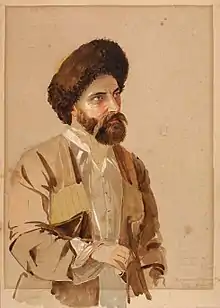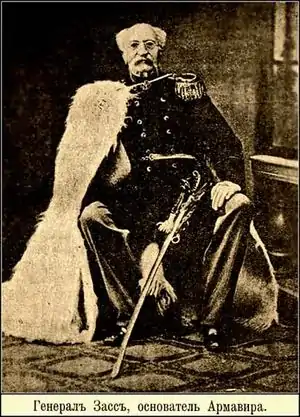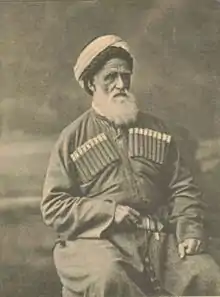Russo-Circassian War
The Russo-Circassian War (Adyghe: Урыс-адыгэ зауэ, romanized: Wurıs-adığə zawə; Russian: Русско-черкесская война, romanized: Russko-cherkesskaya voyna) (1763–1864) refers to the war in Circassia, the northwestern part of the Caucasus, during the course of the Russian Empire's conquest of the Caucasus. Those who use the term Russian–Circassian War take its starting date as 1763, when the Russians began establishing forts, including at Mozdok, to be used as springboards for conquest;[13] and only ending approximately 101 years later, with the last army of Circassia defeated on 2 June [O.S. 21 May] 1864.
| Russo-Circassian War | |||||||||
|---|---|---|---|---|---|---|---|---|---|
| Part of the Caucasian War | |||||||||
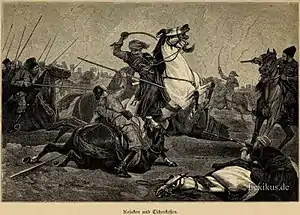 Circassian defence forces fighting a Russian army | |||||||||
| |||||||||
| Belligerents | |||||||||
Diplomatic support: |
Diplomatic support and lend-lease: | ||||||||
| Commanders and leaders | |||||||||
|
|
| ||||||||
| Strength | |||||||||
| 150.000–200.000 regulars[1] | 20.000 regulars[2] | ||||||||
| Casualties and losses | |||||||||
|
- 250.000[3]-400.000 - 1.000 (Estimate) - 251.000-401.000 |
- 375.000 (Estimate)[4]
- 1.575.000 (Estimate)
| ||||||||
| During the Circassian Genocide, about 1,500,000[7][8][9][10][11] indigenous highland Caucasians were expelled mainly to the Ottoman Empire, and a much smaller number to Persia. An unknown number of those expelled died during deportation.[12] | |||||||||
The Russo-Circassian War was the western phase of the Caucasus War of 1817–1864, during which Russia gained control of the free mountaineers of the Caucasus mountains. The eastern phase was the Murid War of 1829–1859.
After the end of the war the Ottoman Empire offered to harbour the Muslim Circassians who were exiled during the Circassian genocide, 800,000–1,500,000 Circassians[7][8][9][10][14][11] (at least 75% of the total population) were exiled to Ottoman territory.[13][15] Different smaller numbers ended up in neighbouring Persia. During the process, the Russian and Cossack forces used various brutal methods to entertain themselves and scare off the native Circassians, such as tearing the bellies of pregnant women and removing the baby inside, then feeding the babies to dogs.[7]
Early relations between Russian Empire and Circassians

Circassia (/sɜːrˈkæʃə/; Adyghe: Адыгэ Хэку) is a former region in the North Caucasus along the northeast shore of the Black Sea.[16] It is the homeland of the Circassian people.
The Circassians were rarely politically united for a long period. In the western bulk of Circassia, they were divided into ten princedoms, living in communities headed by chieftains. In the east of Circassia there was the Kabardian princedom.
In the 1550s, Prince Temruk (Prince Inal's son) allied the Russian Tsar Ivan IV and built a defense. Circassians were Christians during this period and Islam had not begun to spread.[17] In 1556, Circassians carried out a series of military operations in which the Tatar military bases Temryuk and Taman established on Circassian territory were re-captured. In 1561, Ivan the Terrible married Goshan, daughter of the Kabardinian prince Temruk Idar, and named him Mariya.
War
In 1714, Peter I established a plan to occupy the Caucasus. Although he was unable to implement this plan, he laid the political and ideological foundation for the occupation to take place. Catherine II started putting this plan into action. The Russian army was deployed on the banks of the Terek River.
While 15 Circassian princes wanted to fight the Russians with the support of the Ottomans and Crimea, 13 princes wanted to do diplomacy with Russia. Russia built a large barracks on the banks of the Terek River in 1763. Small-scale battles were fought in 1763. Knowing the destructive power of Russia, Circassian princes tried to establish diplomatic relations. In 1764 prince Keysin Keytiqo and knight Kundeyt Shebez-Giray II met with Catherine II in St. Petersburg. They informed Catherine II that "the military build-up in Mezdeug was unacceptable, the region has been a land of Circassians since ancient times, the situation would create hostility and conflict".
Katerina II refused diplomacy and the envoys were sent back. After this, the High Council of Kabardia convened and decided that war was inevitable. In 1769, the Russian army fought against the Kabardinians under the command of General De-Medem, of French origin, with the support of the Kalmyk Khan Ubashi's 20,000 cavalrymen. The fact that Kalmyks was on the Russian side was a shock to the whole Caucasus, which greatly benefited the Russian empire.
In 1758, Sheik Mansur rose to the position of leader of Chechnya, preaching holy war against the invaders.
The Russian conquest of Kabardia was almost a separate conflict from the conquest of Circassia proper. In 1777 the line was extended from Mozdok northwest to Azov.
After General De-Medem conveyed the message to the envoys that Eastern Circassia is Russian territory, Circassian diplomats declared that they would not surrender. A great battle took place in the Nartsane area in June 1769. Although neither side could gain the upper hand, Circassian forces under the leadership of Hatokhhushoqo Bomet Misost inflicted huge losses on the Russian army.
The Russian army attacked the Abaza, Besleney, Chemguy and Hatuqwai tribes in 1787, burning 300 villages. Following this, Circassians sent a group of envoys led by Tatarhan Kurighoqo and
Sidak Jankat to St. Petersburg. The Russian tsar sent the envoys back, saying that the war would not stop and the Circassians were no longer free.[7]
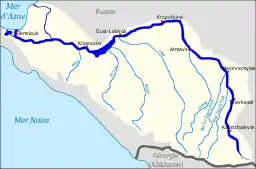
From about 1777 the Russians built a line of forts from Mozdok northwest to Azov. The presence of Cossacks in former grazing lands slowly converted traditional raiding from a kind of ritualized sport into a serious military struggle.
Some historians have stated that that the Circassians should have formed an organized state to resist the Russians, however fact remains that the disorganized Circassians held out longer than the organized Murids. The Turks had a Wali at Anapa or Sujuk-Kale who tried to unite some of the tribes under Ottoman control. Richmond[18] says that in 1791 the Natukhai commoners peacefully took power from the aristocrats. A similar attempt among the Shapsugs led to a civil war which the commons won in 1803. Jaimoukha[19] says that in 1770–1790 there was a class war among the Abadzeks that resulted in the extermination of the princes and the banishment of most of the nobility. Henceforth the three west-central "democratic" tribes, Natukhai, Shapsugs and Abedzeks, who formed the majority of the Circassians, managed their affairs through assemblies with only informal powers. This made things difficult for the Russians since there were no chiefs who might lead their followers into submission. Sefer Bey Zanuqo, the three Naibs of Shamil and the British adventurers all tried to organize the Circassians – with limited success.
In 1800, as part of the Russian conquest of the Caucasus, Russia annexed eastern Georgia and by 1806 held Transcaucasia from the Black Sea to the Caspian. Since Russia also claimed the steppes north of the mountains its claims were divided by the free mountaineers of the Caucasus. Russia had to hold the Georgian Military Highway in the center so the war against the mountaineers was divided into eastern and western parts.
Some Russian armies crossed the Kuban River on March 1814. Circassia used this diplomatic opportunity to promote the young prince Jembulat Bolotoqo and sent a delegation to Ottomans, which complained against the Russian actions.[20][21][22]
Deciding that Circassians would not surrender, Russia began to destroy Circassian villages and towns and slaughter the people.[23][24][25] General Aleksey Yermolov conclude that "terror" would be effective toward frontier protection instead of fortress construction as "moderation in the eyes of the Asiatics is a sign of weakness".[26]
In 1805, a major plague struck the north Caucasus and carried away a large part of the Kabardian population. (One source[27] says the Kabardians were reduced from 350,000 "before the war" to 50,000 in 1818. Another[28] gives populations of 200,000 in 1790 and 30,000 in 1830.) Taking advantage of this, in 1805 General Grigoriy Glazenap burned eighty villages. In 1810 about 200 villages were burned. In 1817 the frontier was pushed to the Sunzha River and in 1822 a line of forts was built from Vladikavkaz northwest through Nalchik to the Pyatigorsk area. After 1825 fighting subsided. Between 1805-1807, Bulgakov's army burned more than 280 villages. The population of Kabarda, which was 350,000 in 1763, was only 37,000 in 1817.[29]
These cruel tactics annoyed the Circassians even more. After this, many Circassian princes, even princes who had been competing for centuries, joined hands to resist harder, and so many invading Russian armies were defeated, some completely destroyed. In Europe, especially in England, there was great sympathy for the Circassians who resisted the Russians.[30]
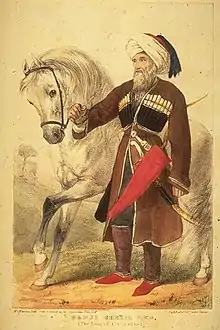
In response to persistent Circassian resistance and the failure of their previous policy of building forts, the Russian military began using a strategy of disproportionate retribution for raids. With the goal of imposing stability and authority beyond their current line of control and over the whole Caucasus, Russian troops retaliated by destroying villages or any place that resistance fighters were thought to hide, as well as employing assassinations and executions of whole families.[31] Understanding that the resistance was reliant on being fed by sympathetic villages, the Russian military also systematically destroyed crops and livestock.[32] These tactics further enraged natives and intensify resistance to Russian rule. The Russians began to counter this by modifying the terrain, in both the environment and the demographics. They cleared forests by roads, destroyed native villages, and often settled new farming communities of Russians or pro-Russian Orthodox peoples. In this increasingly bloody situation, the complete destruction of the villages for Russian interests with everyone and everything within them became.a standard action by the Russian army and Cossack units.[33]
Nevertheless, the Circassian resistance continued. Villages that had previously accepted Russian rule were found resisting again, much to the ire of Russian commanders.[34]
Jembulat Boletoqo led an 800 strong cavalry force into Russian territory. Only one Cossack regiment decided to fight the rising Circassian army on October 23 at the village of Sabl on the Barsukly River. Jembulat's forces surrounded the Cossacks and killed all of them in a saber attack.[5][35]
In the summer of 1825, Russian forces carried out several military operations. On August 18, General Veliaminov burned the residency of Hajji Tlam, one of the leaders of the Circassian resistance in Abadzekh, and killed his entire family. On January 31, Jembulat burned down the fortress of Marevskoye as revenge.[36][37] On June 4, 1828, Jembulat Boletoqo started his campaign into Russian lands with 2,000 cavalry under five flags of different Circassian principalities, as well as a Turkish flag as a symbol of their loyalty to Islam.

Circassian political analyst Khan-Girei observed that the situation changed for Great-Prince Jembulat “after the field marshal Paskevich left the region”.[38] The new commander-in-chief, Baron Rosen, did not believe in human rights of the indigenious Circassians.[39][40]
The Russians besieged Anapa again in 1828. The Ottomans sought help from Circassians and the war lasted for two months. Anapa fell into the hands of the Russians. General Emanuel, commander of Russia's Caucasus armies, enraged, then razed 6 Natukhay villages and many Shapsugh villages. He then passed the Kuban and burned 210 more villages.
Treaty of Adrianople (1829) was signed on September 14, 1829. According to this agreement, the Ottoman Empire was giving the Caucasus to Russia. Many, including German economist Karl Marx, criticised this event.
Circassians did not recognize the treaty. Circassian ambassadors were sent to England, France and Ottoman lands. The mission of the messengers was to tell about the savagery and destruction. Meanwhile, Nicholas I was issuing orders for the complete elimination of the Circassians.
In November 1830 the Natukhais and Shapsugs sent a delegation to Turkey under Sefer Bey Zanuqo. The delegation returned with a few weapons and Sefer Bey remained in Istanbul.
Before 1830 Russia basically maintained a siege line along the Kuban River. There was constant raiding by both sides but no change in borders. In the late 1830s Russia gained increasing control of the coast.
In 1833, Colonel Grigory Zass was appointed commander of a part of the Kuban Military Line with headquarters in the Batalpashinsk fortress. Colonel Zass received wide authority to act as he saw fit. Grigory Zass had racist views and regarded the Circassians as a lower race than the Russians and other "civilized Europeans". In his view, the only way to deal with the Circassians was to scare them. From that concept, Zass developed new military methods – burning people alive, and cutting off the heads of corpses.[41][42]
Colonel Grigory Zass played a major role in the Circassian genocide via ethnic cleansing with many methods such as burning Circassian villages whole, deliberately causing epidemics, entering villages and towns with the white flag and then killing everyone. It is estimated that around 70% of the East Circassian population died in the process.[43][44] In addition, it was recorded that Zass dismembered Circassian corpses, hid them as ornaments and sent them abroad to be used as test subjects.
In October 1836, General Zass sent Great Prince Jembulat word that he would like to make peace. This was a strategy, if Boletoqo came to the Russian fortress for explanation, he would be assassinated; in case he did not come, the Russians would claim that he was a warmonger who did not want peace.[45]
Prince Boletoqo came to Zass’ residency. The general was not there for his first visit, but Zass told him to come at an exact date when he would certainly be in his residency. On his way to the Prochnyi Okop fortress, Great Prince Jembulat was killed by a Russian sniper who was hiding in the forest on the Russian bank of the Kuban River at the intersection with the Urup River.[46]
In 1836 the Russians captured a British gun-runner, the Vixen, and for the next few years several British adventurers operated in Circassia. Their exact relation to the British government is uncertain, however most historians agree they could have been British spies.
In 1837, some Circassian leaders offered the Russians a white peace, saying that no more blood should be shed. In response to this offer, the Russians burned 36 Circassian villages and sent word, "We need Circassian lands, not the Circassian people," sent by General Yermolov.[47]
Shamil wanted to unite Circassia under Islam, and sent three naibs for this mission.
The first Naib was Haji-Mohammad (1842–1844) who reached Circassia in May 1842. By October he was accepted as leader by the Shapsugs and some of the Natukhais. Next February he moved south to Ubykh country but failed because he took sides in a civil conflict. By late 1843 he had the allegiance of the Natukhais, Shapsugs and the Beslaneys and sent raiding parties as far as Stavropol. In the spring of 1844 he was defeated by the Russians, withdrew into the mountains and died there in May.
The second naib was Suleiman Efendi (1845) who arrived among the Abadzeks in February 1845. His main goal was to rise a Circassian force and to lead it back to Chechnya, but the Circassians did not want to lose their best fighters. After twice failing to lead his recruits through the Russian lines he surrendered and joined the Russians.
_Amin_ibn_Hajjio_al-Honodi_al-Daghestani.gif)
The third naib, Muhammad Amin (1849–1859), arrived in spring of 1849 and had much greater success. He established a standing army, started the manufacture of gunpowder and built the first jails. By mid-1851 he was greatly weakened but by the spring of 1853 he had regained control. The Crimean War began in October 1853 and in the following spring Sefer Bey returned from Istanbul to Sukhum-Kale. Meeting no success he moved to Anapa where the Natukhais accepted him as leader. Amin went to Istanbul to sort things out. Receiving no support he returned to Circassia and the two would-be leaders began to fight, the Natukhais supporting Sefer Bey and the Abadzeks and Bzhedugs supporting Amin. When the allies asked Sefer Bey to turn over Anapa he replied that it was sovereign Circassian territory, thereby breaking with his protectors. When the Crimean War ended in 1856 Russia had a free hand in Circassia and the two leaders continued to fight both the Russians and each other. They agreed that the Porte should appoint a single leader; Amin went to Istanbul, but Sefer-Bei stayed and worked against him. Amin returned, went again to Istanbul, was arrested at the request of the Russian ambassador, was sent to Syria, escaped and returned to Circassia by the end of 1857. On 20 November 1859, following the defeat of Shamil, Amin submitted. He stayed in Shapsug country for a while, then emigrated to Istanbul. Sefir-Bei died in December of that year. His son Karabatyr took over but our sources do not say what happened to him.
In the Paris treaty of 1856, British representative Earl of Clarendon insisted that Circassia remain an independent state, but French, Russian and Ottoman representatives wanted to give Circassian lands to Russia.[48][49][50] When Clarendon then tried to make the treaty state that Russia could not build forts in Circassia, he was again thwarted by the French representative. The final treaty also extended amnesty to nationals that had fought for enemy powers, but since Circassia had never previously been under Russian control, Circassians were exempt, and thus Circassians were now placed under de jure Russian sovereignty by the treaty, with Russia under no compulsion to grant Circassians the same rights as Russian citizens elsewhere.[51][52][53]
In 1857, Dmitry Milyutin published the document in which he argued that the Circassian people should be destroyed.[54] According to Milyutin, the issue was not to take over the Circassian lands, but to put an end to the Circassians.[55][56][57] Rostislav Fadeyev supported the proposal, saying "It is not possible to tame the Circassians, if we destroy half of them completely, the other half will lay down their weapons".[58] By 1860 the Russians had seventy thousand soldiers in Circassia.
Circassians established an assembly called Independence Majlis of Circassia (Adyghe: Шъхьафитныгъэ Хасэ, romanized: Şhafitnığə Xasə, lit. 'Majlis of Independence') in the capital city of Ş̂açə (Sochi) on June 25, 1861. Qerandiqo Berzeg was appointed as the head of the assembly. This assembly asked for help from Europe,[59] arguing that they would be forced into exile soon. However, before the result was achieved, Russian General Kolyobakin invaded Sochi and destroyed the parliament[60] and no country opposed this.[59]
According to Ivan Drozdov, for the most part, the Russian army preferred to indiscriminately destroy areas where Circassians resided. In September 1862, General Yevdokimov, after receiving the news that the elderly, women and children escaped and fled into the forest after an attack on a Circassian village, ordered his soldiers to siege that forest for six hours after which time he set the forest on fire.
With the operation launched from the autumn of 1863, the Circassian villages and their supplies were to be burned, and this process was repeated until General Yevdokimov was convinced that all the inhabitants of the region had died.[61][62]
A final battle took place in Qbaada in 1864 between the Circassian army of 20,000 tribal horsemen and a Russian army of 100,000 men, consisting of Cossack and Russian horsemen, infantry and artillery.[63] Circassian warriors decided to attack the Russian army, stating "they would not even think of surrender", and tried to break the line, but most were hit by Russian artillery and infantry before they even managed to reach the front. The remaining fighters continued to fight as militants and were soon defeated. All 20,000 Circassian horsemen died in the war. The Russian army began celebrating victory on the corpses of Circassian soldiers, so this was officially the end of the war. The place where this battle took place is known today as Krasnaya Polyana. "Krasnaya Polyana" means red meadow. It takes its name from the Circassian blood flowing from the hill into the river. The river ran red for weeks after the war. Circassian exile and genocide started after the Qbaada war. The Russians began raiding and burning Circassian villages, destroying fields to prevent return, cutting down trees, and driving the people to the Black Sea coast. Russian soldiers used many brutal methods to entertain themselves, such as tearing the belly of pregnant women and removing the baby inside.[7]
After these events, Circassia fell into Russian hands. The only exception, the Hak'uch, who lived in the mountainous regions and called by the Russians flying forest thugs in the sense of hate, did not agree to leave their land, despite being surrounded and unequipped, they continued their resistance until the 1870s. In the end, Circassia was subjected to genocide and ethnic cleansing throughout, almost entirely.
Expulsion and genocide
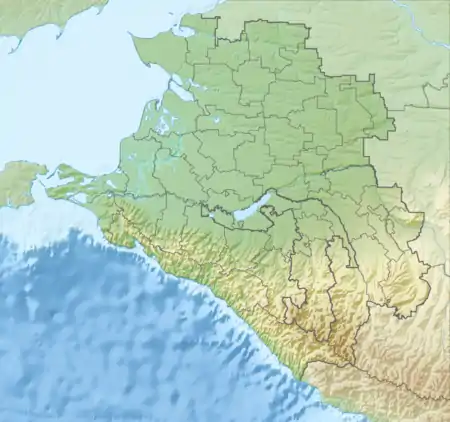
The Natukhais and Shapsugs along the narrow coastal plain were less numerous than their brothers north of the mountains.
The curved line from the Temirgoys to the Baslaney is the Laba River, an inner tributary of the Kuban River.
The Circassian genocide was the Russian Empire's systematic mass murder,[64][65][66][67] ethnic cleansing,[68][65][66][67] forced migration,[69][65][66][67] and expulsion[70][65][66][67] of 800,000–1,500,000 Circassians[71][72][65][66][67] (at least 75% of the total population) from their homeland Circassia, which roughly encompassed the major part of the North Caucasus and the northeast shore of the Black Sea.[71] It has been recorded that during the events, the Russian and Cossack forces used various brutal methods to entertain themselves, such as tearing the bellies of pregnant women and removing the baby inside, then feeding the babies to dogs.[71][73] Russian generals such as Grigory Zass described the Circassians as "subhuman filth", and justified their killing and use in scientific experiments.[74] The displaced people were settled primarily to the Ottoman Empire.[71]

In 1857, Dmitry Milyutin first published the idea of mass expulsions of Circassian natives.[75] Miliutin argued that the goal was not to simply move them so that their land could be settled by productive farmers, but rather that "eliminating the Circassians was to be an end in itself – to cleanse the land of hostile elements".[75][76] The decision was made at a meeting in Vladikazkaz in October 1860. The motion was proposed by General Yevdokimov and supported by Baryatinsky and Miliutin, only Filipson objecting. Tsar Alexander II endorsed the plans,[75] and Milyutin later would become the minister of war in 1861, and from the early 1860s expulsions began occurring in the Caucasus (first in the Northeast and then in the Northwest).[75][76]
Yevdokimov was tasked with enforcing the policy, using mobile columns of Russian riflemen and Cossack cavalry.[77][78][79] "In a series of sweeping military campaigns lasting from 1860 to 1864 ... the northwest Caucasus and the Black Sea coast were virtually emptied of Muslim villagers. Columns of the displaced were marched either to the Kuban [River] plains or toward the coast for transport to the Ottoman Empire. ... One after another, entire Circassian tribal groups were dispersed, resettled, or killed en masse"[79] Such tactics had been in use for a number of years. Count Leo Tolstoy, the future author of War and Peace, saw action in the war in 1850–51. He described how "It had been the custom to rush the auls [mountain villages] by night, when, taken by surprise, the women and children had no time to escape, and the horrors that ensued under the cover of darkness when the Russian soldiers made their way by twos and threes into the houses were such as no official narrator dared describe"[80] Similar atrocities committed in the final campaign of 1859–1864 were recorded by contemporary Russian observers and British consuls.[79] A consul Dickson recounted in an 1864 dispatch: "A Russian detachment having captured the village of Toobah on the Soobashi river, inhabited by about a hundred Abadzekh [a tribe of Circassians], and after these had surrendered themselves prisoners, they were all massacred by the Russian Troops. Among the victims were two women in an advanced state of pregnancy and five children. The detachment in question belongs to Count Evdokimoff's Army, and is said to have advanced from the Pshish valley. As the Russian troops gain ground on the [Black Sea] Coast, the natives are not allowed to remain there on any terms, but are compelled either to transfer themselves to the plains of the Kouban or emigrate to Turkey".[81]
The drives seem to have started in 1861–62. Some wealthy Circassians had already left in 1860 and 10,000 Kabardians in 1861.[82] In April 1862, 15,000 Temirgoys were driven to the coast and in May the pacified Natukhajs. In May 1862 a commission was formed to organize the deportation. Each deported family was to be given 10 rubles. The number of people expelled was several hundred thousand, with a large percent dying on the march, waiting on the beach, on overloaded boats or of plague after arrival on the Turkish shore. The future Kuban Oblast lost 94 percent of its population. Richmond estimates population changes in the northwest Caucasus as follows: (1835 and 1882, in thousands) Circassians: at least 571 to 36 and Kabardians: 15 to 15;[83] non Circassian Abazas : 70 to 10; and Karachays: 24 to 17. Russians and Ukrainians however increased: 110 to 926. The surviving Circassians were south of Krasnodar, inside the Laba River bend and on the west side of the upper Kuban and some Shapsugs around on the Black Sea coast.
The last battle of the war occurred at Qbaada Meadow near Sochi on 27 May 1864 when the Russians defeated a group of Ubyks. On 2 June Evdokimov declared the war over and held a victory parade. In 1869 the place was settled by Russians and named Krasnaya Polyana.
Consequences
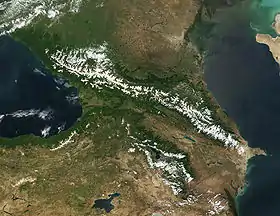
This expulsion, along with the actions of the Russian military in acquiring Circassian land,[15] has given rise to a movement among descendants of the expelled ethnicities for international recognition that genocide was perpetrated.[84] Some sources state that hundreds of thousands of others died during the exodus.[15] Several historians use the term 'Circassian massacres'[85] for the consequences of Russian actions in the region.[86]
Circassian historians cite casualty figures that lie near the four million mark, while official Russian figures are near 300,000. The Russian census of 1897 records only 150,000 Circassians, one tenth of the original number, still remaining in the now conquered region.[87] In reference to the actions of the Russian army during the conflict, Russian President Boris Yeltsin stated in May 1994 that resistance to the tsarist forces was legitimate; however, he did not recognize "the guilt of the tsarist government for the genocide."[88]
Circassians have attempted to attract global media attention to the Circassian Genocide and its relation to the city of Sochi (where the Olympics were held in 2014, on the official anniversary of the genocide) by holding mass protests in Vancouver, Istanbul and New York during the 2010 Vancouver Winter Olympics.[89][90]
In October 2006, the Adyghe (Circassian) organizations of many countries in North America, Europe and the Middle East sent the president of the European Parliament a letter requesting recognition of the genocide.[84][88]
On 20 March 2010, a Circassian Genocide Congress was held in Tbilisi, Georgia.[91][92] The congress passed a resolution, urging Georgia to recognize the Circassian Genocide.[92]
Some sources state that three million Circassians were evicted from Circassia in a period lasting until 1911.[93] Other sources cite upwards of two million Circassian refugees fleeing Circassia by 1914 and entering nations and regions such as the Balkans, Turkey, what was the Ottoman Empire in what was known as the Muhajir, Iran, the Qajar dynasty also as Muhajir, Syria, Lebanon, what is now Jordan, Kosovo, Egypt (Circassians had been part of the Mamluk armies since the Middle Ages), Israel (in the villages of Kfar Kama and Rikhaniya, since 1880) and as far afield as upstate New York and New Jersey.
Some 90 percent of people with Circassian descent now live in other countries, primarily in Turkey, Jordan and other countries of the Middle East, with only 500,000–700,000 remaining in what is now Russia.[15] The depopulated Circassian lands were resettled by numerous ethnic groups, including Russians, Ukrainians and Georgians.[15] Friction developed between the latter group and the remaining indigenous people in Abkhazia, a factor later contributing to friction between the two ethnic groups and the resulting War in Abkhazia.[15]
See also
Citations and notes
- Mackie 1856:291
- Mackie 1856:292
- Grigori F. Krivosheev Россия и СССР в войнах XX в. Потери вооружённых сил. Олма-Пресс, 2001.: Вооружённые конфликты на Северном Кавказе (1920—2000 гг.). p.568
- "Victimario Histórico Militar".
- "Jembulat Bolotoko: The Prince of Princes (Part One)". Jamestown. Retrieved 5 January 2021.
- Richmond, Walter. The Circassian Genocide. ISBN 9780813560694.
- Richmond, Walter (2013). The Circassian Genocide. Rutgers University Press. back cover. ISBN 978-0-8135-6069-4.
- Ahmed 2013, p. 161.
- Richmond, Walter (9 April 2013). The Circassian Genocide. Rutgers University Press. ISBN 978-0-8135-6069-4.
- Geçmişten günümüze Kafkasların trajedisi: uluslararası konferans, 21 Mayıs 2005 (in Turkish). Kafkas Vakfı Yayınları. 2006. ISBN 978-975-00909-0-5.
- "Tarihte Kafkasya - ismail berkok | Nadir Kitap". NadirKitap (in Turkish). Retrieved 26 September 2020.
- McCarthy 1995:53, fn. 45
- Henze 1992
- King 2008:96
- Shenfield 1999
- Chisholm, Hugh, ed. (1911). . Encyclopædia Britannica. 6 (11th ed.). Cambridge University Press. pp. 380–381.
- Shenfield 1999:150
- p. 55. He says nothing about the Abadzeks.
- p. 156
- "Jembulat Bolotoko: The Prince of Princes (Part One)". Jamestown. Retrieved 5 January 2021.
- 6. AKAK, v. 5, p. 872.
- Ibid., p. 873.
- King, Ghost of Freedom, p47-49. Quote on p48:This, in turn, demanded...above all the stomach to carry the war to the highlanders themselves, including putting aside any scruples about destroying, forests, and any other place where raiding parties might seek refuge... Targeted assassinations, kidnappings, the killing of entire families and the disproportionate use of force became central to Russian operations...
- King, The Ghost of Freedom, 74
- Ahmed 2013, p. 161.
- Ahmed 2013, p. 161.
- Jaimouka, p. 63
- Richmond, p. 56
- Richmond, page 56
- King, Ghost of Freedom, p93-94
- King, Ghost of Freedom, pp. 47–49. Quote on p. 48:This, in turn, demanded ... above all the stomach to carry the war to the highlanders themselves, including putting aside any scruples about destroying, forests, and any other place where raiding parties might seek refuge. ... Targeted assassinations, kidnappings, the killing of entire families and the disproportionate use of force became central to Russian operations...
- King, The Ghost of Freedom, 74
- King, The Ghost of Freedom, p73-76. p74:"The hills, forests and uptown villages where highland horsemen were most at home were cleared, rearranged or destroyed... to shift the advantage to the regular army of the empire."... p75:"Into these spaces Russian settlers could be moved or "pacified" highlanders resettled."
- King, Ghost of Freedom, pp. 93–94
- Potto V. Kavkazskaya Voina, v.2, p. 45
- "JEMBULAT BOLOTOKO: PRENSLERİN PRENSİ (PŞIXEM 'ARİPŞ*)". cherkessia.net. 2013. Retrieved 5 January 2021.
- Ibid., p. 59.
- Sherbina F. A. Istoriya Armavira I Cherkeso-gayev (Ekaterinodar, 1916), p. 11.
- "Jembulat Bolotoko: The Prince of Princes (Part One)". Jamestown. Retrieved 5 January 2021.
- Bell, James. Journal of a residence…, p. 422.
- "Jembulat Bolotoko: The Prince of Princes (Part One)". Jamestown. Retrieved 5 January 2021.
- Ibid., p. 420.
- Richmond, Walter (2 September 2013). "Velyaminov, Zass ve insan kafası biriktirme hobisi". Jıneps Gazetesi (in Turkish). Retrieved 26 September 2020.
- Щербина Ф. А. История Армавира и черкесо-горцев. — Екатеринодар: Электро-тип. т-во «Печатник», 1916.
- "JEMBULAT BOLOTOKO: PRENSLERİN PRENSİ (PŞIXEM 'ARİPŞ*)". cherkessia.net. 2013. Retrieved 5 January 2021.
- "Jembulat Bolotoko: The Prince of Princes (Part One)". Jamestown. Retrieved 5 January 2021.
- Natho, Kadir I. Circassian History. Page 357.
- Richmond, Walter. The Circassian Genocide. Page 63
- Baumgart. Peace of Paris. Pages 111– 112
- Conacher. Britain and the Crimea. pages 203, 215– 217.
- Richmond, Walter. The Circassian Genocide. Page 63
- Baumgart. Peace of Paris. Pages 111– 112
- Conacher. Britain and the Crimea. pages 203, 215– 217.
- King, Charles. The Ghost of Freedom: A History of the Caucasus. Page 94. In a policy memorandum in of 1857, Dmitri Milyutin, chief-of-staff to Bariatinskii, summarized the new thinking on dealing with the northwestern highlanders. The idea, Milyutin argued, was not to clear the highlands and coastal areas of Circassians so that these regions could be settled by productive farmers...[but] Rather, eliminating the Circassians was to be an end in itself – to cleanse the land of hostile elements. Tsar Alexander II formally approved the resettlement plan...Milyutin, who would eventually become minister of war, was to see his plans realized in the early 1860s.
- King, Charles. The Ghost of Freedom: A History of the Caucasus. Page 94. In a policy memorandum in of 1857, Dmitri Milyutin, chief-of-staff to Bariatinskii, summarized the new thinking on dealing with the northwestern highlanders. The idea, Milyutin argued, was not to clear the highlands and coastal areas of Circassians so that these regions could be settled by productive farmers...[but] Rather, eliminating the Circassians was to be an end in itself – to cleanse the land of hostile elements. Tsar Alexander II formally approved the resettlement plan...Milyutin, who would eventually become minister of war, was to see his plans realized in the early 1860s.
- L.V.Burykina. Pereselenskoye dvizhenie na severo-zapagni Kavakaz. Reference in King.
- Richmond 2008, p. 79. "In his memoirs Milutin, who proposed deporting Circassians from the mountains as early as 1857, recalls: "the plan of action decided upon for 1860 was to cleanse [ochistit'] the mountain zone of its indigenous population.".
- Ahmed 2013, p. 161.
- Richmond, Walter. Circassian Genocide. Page 72
- Prof.Dr. ĞIŞ Nuh (yazan), HAPİ Cevdet Yıldız (çeviren). Adigece'nin temel sorunları-1. Адыгэ макъ,12/13 Şubat 2009
- Richmond, Walter. The Circassian Genocide. Page 81.
- Field notes of Evdokimov for June–December 1863, available from the Georgian State Archives, Tbilisi. f.416, op. 3, doc. 1177, 100-190 passim.
- Неизвестные войны России. Взятие Кбааде и завершение Кавказской войны в 1864 г.
- "We Will Not Forget the Circassian Genocide!". www.hdp.org.tr (in Turkish). Retrieved 26 September 2020.
- Richmond, Walter (9 April 2013). The Circassian Genocide. Rutgers University Press. ISBN 978-0-8135-6069-4.
- Geçmişten günümüze Kafkasların trajedisi: uluslararası konferans, 21 Mayıs 2005 (in Turkish). Kafkas Vakfı Yayınları. 2006. ISBN 978-975-00909-0-5.
- "Tarihte Kafkasya - ismail berkok | Nadir Kitap". NadirKitap (in Turkish). Retrieved 26 September 2020.
- "UNPO: The Circassian Genocide". unpo.org. Retrieved 26 September 2020.
- Coverage of The tragedy public Thought (later half of the 19th century), Niko Javakhishvili, Tbilisi State University, 20 December 2012, retrieved 1 June 2015
- "The Circassian exile: 9 facts about the tragedy". The Circassian exile: 9 facts about the tragedy. Retrieved 26 September 2020.
- Richmond, Walter (2013). The Circassian Genocide. Rutgers University Press. back cover. ISBN 978-0-8135-6069-4.
- Ahmed 2013, p. 161.
- Gazetesi, Aziz ÜSTEL, Star. "Soykırım mı; işte Çerkes soykırımı - Yazarlar - Aziz ÜSTEL | STAR". Star.com.tr. Retrieved 26 September 2020.
- Gazetesi, Jıneps (2 September 2013). "Velyaminov, Zass ve insan kafası biriktirme hobisi". Jıneps Gazetesi (in Turkish). Retrieved 26 September 2020.
- King, Charles. The Ghost of Freedom: A History of the Caucasus. p. 94. In a policy memorandum in of 1857, Dmitri Miliutin, chief-of-staff to Bariatinskii, summarized the new thinking on dealing with the northwestern highlanders. The idea, Miliutin argued, was not to clear the highlands and coastal areas of Circassians so that these regions could be settled by productive farmers...[but] Rather, eliminating the Circassians was to be an end in itself – to cleanse the land of hostile elements. Tsar Alexander II formally approved the resettlement plan...Milyutin, who would eventually become minister of war, was to see his plans realized in the early 1860s.
- L.V.Burykina. Pereselenskoye dvizhenie na severo-zapagni Kavakaz. Reference in King.
- Levene 2005:297
- Richmond, Chapter 4
- King 2008:94–96
- Baddeley 1908:446
- Cited in McCarthy 1995:34
- Walter Richmond, Northwest Caucasus, p. 75. This seems to contradict Richmond's Table 5.1 copied at the bottom of this paragraph
- see previous footnote
- UNPO 2006.
- Levene 2005:299
- Levene 2005:302
- UNPO 2004
- Goble 2005.
- Murat Temirov (3 January 2010). "Fire and Ash Olympics". Adyghe Heku. Retrieved 7 April 2010.
- Zhemukhov, Sufian (September 2009). "The Circassian Dimension of the 2014 Sochi Olympics". PONARS Policy Memo No. 65 – Georgetown University. Circassian World. Archived from the original on 11 October 2009. Retrieved 28 November 2009.
- Ferris-Rotman, Amie (21 March 2010). "Russian Olympics clouded by 19th century deaths". Yahoo!News. Reuters. Retrieved 5 April 2010.
- Dzutsev, Valery (25 March 2010). "Circassians Look to Georgia for International Support". Eurasia Daily Monitor. jamestown.org. 7 (58). Retrieved 12 January 2017.
- Karpat 1985.
More References
- Henze, Paul B. 1992. "Circassian resistance to Russia." In Marie Bennigsen Broxup, ed., The North Caucasus Barrier: The Russian Advance Towards The Muslim World. London: C Hurst & Co, 266 pp. (Also New York: St. Martin's Press, 252 pp.) Part of it can be found here. Retrieved 11 March 2007.
- Richmond, Walter (2008). The Northwest Caucasus: Past, Present, Future. Routledge. ISBN 978-0-415-77615-8. Archived from the original on 27 September 2007: Chapter 4 (excerpt)
- Tsutsiev, Arthur, Atlas of the Ethno-Political History of the Caucasus, 2014
Further reading
- Baddeley, John F. (1908). The Russian conquest of the Caucasus. London: Longmans, Green and Co. ISBN 0-7007-0634-8. OL 3428695M.
- Goble, Paul. 2005. Circassians demand Russian apology for 19th century genocide. Radio Free Europe / Radio Liberty, 15 July 2005, 8(23).
- Karpat, Kemal H. 1985. Ottoman Population, 1830–1914: Demographic and Social Characteristics. Madison, Wis.: University of Wisconsin Press.
- Levene, Mark. 2005. Genocide in the Age of the Nation State. London; New York: I.B. Tauris.
- King, Charles. 2008. The Ghost of Freedom: A History of the Caucasus. Oxford Univ. Press.
- Mackie, J[ohn] Milton. 1856. Life of Schamyl: and narrative of the Circassian War of independence against Russia. ISBN 1-4255-2996-8
- McCarthy, Justin. 1995. Death and Exile: The Ethnic Cleansing of Ottoman Muslims, 1821–1922. Princeton, New Jersey: Darwin. Chapter 2: Eastern Anatolia and the Caucasus.
- Neumann, Karl Friedrich. 1840. Russland und die Tscherkessen. Stuttgart und Tübingen: J. G. Cotta. In PDF through Internet Archive
- Shenfield, Stephen D. 1999. The Circassians: a forgotten genocide?. In Levene, Mark and Penny Roberts, eds., The massacre in history. Oxford and New York: Berghahn Books. Series: War and Genocide; 1. 149–162.
- Unrepresented Nations and People Organisation (UNPO). 2004. The Circassian Genocide, 2004-12-14.
- Ibid. 2006. Circassia: Adygs Ask European Parliament to Recognize Genocide, 2006-10-16.
- Journal of a residence in Circassia during the years 1837, 1838, and 1839 – Bell, James Stanislaus (English)
- The Annual Register. 1836. United Kingdom
- Butkov, P.G. 1869. Materials for New History of the Caucasus 1722–1803.
- Jaimoukha, A., The Circassians: A Handbook, London: RoutledgeCurzon; New York; Routledge and Palgrave, 2001.
- Khodarkovsky, Michael. 2002. Russia's Steppe Frontier: The Making of a Colonial Empire, 1500–1800. Bloomington: Indiana University Press. Series: Indiana-Michigan series in Russian and East European studies.
- Leitzinger, Antero. 2000. The Circassian Genocide. In The Eurasian Politician, 2000 October 2000, Issue 2.
- Richmond, Walter. The Circassian Genocide, Rutgers University Press, 2013. ISBN 9780813560694
- Shapi Kaziev. Kaziev, Shapi. Imam Shamil. "Molodaya Gvardiya" publishers. Moscow, 2001, 2003, 2006, 2010
External links
- Abzakh, Edris. 1996. Circassian History.
- Adanır, Fikret. 2007. Course syllabus with useful reading list.
- Hatk, Isam. 1992. Russian–Circassian War, 1763 – 21 May 1864. Al-Waha-Oasis, 1992, 51:10–15. Amman.
- Köremezli İbrahim. 2004. The Place of the Ottoman Empire in the Russo-Circassian War (1830–1864). Unpublished M.A. Thesis, Bilkent University, Ankara, Turkey.
- A collection of cited reports on the conflict, collected by the Circassian World, translated by Nejan Huvaj, and found on this page. Retrieved 11 March 2007
.jpg.webp)
